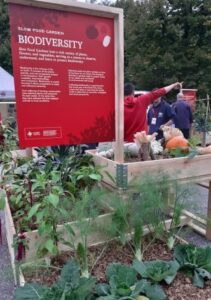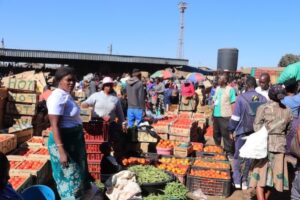
Biodiversity, Climate Change, Conferences, Conservation, Editors’ Choice, Environment, Featured, Food and Agriculture, Food Sustainability, Global, Headlines, Health, Natural Resources, TerraViva United Nations

Biodiversity is key to food security and nutrition. IPBES has warned that loss of biodiversity is accelerating around the world, with 1 million animal and plant species threatened with extinction. Credit: Busani Bafana/IPS
– A holistic approach and transformative change of systems are needed to tackle biodiversity loss and to put the world on a sustainable path, an assessment by the Intergovernmental Science-Policy Platform on Biodiversity and Ecosystem Services (IPBES) has recommended.
The world is facing an interconnected crisis of unprecedented biodiversity loss, food insecurity, and environmental degradation that can no longer be tackled through fragmented and piecemeal solutions, a forthcoming assessment by IPBES will show, calling for holistic approaches instead.
IPBES is set to launch two scientific assessments, the Nexus Assessment and Transformative Change Assessment, in December 2024, which recommend holistic solutions to tackling the connected and converging crises of biodiversity, water, food, health, and climate change because’ “siloed” approaches are proving unsuccessful.’
In addition, the assessment calls for urgent “transformative change” by intergovernmental bodies, private sector organizations and civil society to respond to the nature and climate crises.
IPBES is an intergovernmental organization established to improve the interface between science and policy on issues of biodiversity and ecosystem services.
The historic IPBES Global Assessment Report of 2019 found that meeting global sustainability targets for 2030 and beyond requires a fundamental, system-wide reorganization, including new paradigms.
IPBES Head of Communications, Rob Spaull, said the assessments represent the best science evidence for critical action to tackle biodiversity loss available to policymakers.
“This is the most ambitious science report we have done because these five issues by themselves are complex and this assessment pulls them together,” Spaull said in a pre-report launch media briefing this week.
The Nexus Assessment identifies important trade-offs and opportunities within the multi-dimensional polycrisis: To what extent do efforts to address one crisis add to others? And which policy options and actions would produce the greatest benefits across the board? The report will offer an unprecedented range of responses to move decisions and actions beyond single-issue silos. The report was produced over three years by 101 experts in 42 countries.
“Global crises in biodiversity, water, food, health and climate change often intensify each other when addressed separately and should therefore be tackled together,” said Paula Harrison, co-chair of the IPBES Nexus Assessment report, in a statement.
“The Nexus Assessment is among the most ambitious work ever undertaken by the IPBES community, offering an unprecedented range of response options to move decisions and actions beyond single issue silos.”
The Transformative Change Assessment looks at the underlying causes of biodiversity loss, determinants of transformative change and options for achieving the 2050 Vision for Biodiversity. The report also assesses the determinants of transformative change, the biggest obstacles it faces and how it occurs. It also identifies achievable options to foster, accelerate and maintain transformative change towards a sustainable world and the steps to achieve global visions for transformative change.
A statement by IPBES notes that the Transformative Change Report will provide decision-makers, including policymakers, with “the best available evidence, analysis and options for actions leading to transformative change and build an understanding of the implications of the underlying causes of biodiversity loss for achieving the Paris Climate Agreement, global biodiversity targets under the Kunming-Montreal Global Biodiversity Framework, the Sustainable Development Goals and other major international development objectives.”
The 11th session of the IPBES Plenary, the first ever to take place in Africa from December 10 to 16, will discuss and approve the reports. IPBES represents nearly 150 governments and seeks to strengthen the science-policy interface for biodiversity and ecosystem services.
Spaull said the assessments underline the need to find holistic solutions to addressing biodiversity loss.
“The assessments are looking at how when you try and fix one part of the system you have unintended consequences in other parts of the system; for instance, in many countries there is a big push to plant trees to mitigate climate change and for carbon sequestration and with (unintended) consequences for biodiversity. For example, planting one kind of tree may be damaging to the ecology or water supply and also have an impact on health, so it means there is a need to find a balance.”
He said the reports also highlight responding to issues simultaneously, which is also the emphasis on meeting the SDGs, which have to be addressed systematically rather than in silos.
“For example, there has been a big increase in the volume of food production in past decades and an increase in caloric output that has helped global health but on the other hand, this has resulted in biodiversity loss because the massive food production has been done through intensive agriculture methods that deplete water and have massive gas emissions,” said Spaull.
Furthermore, IPBES has influenced and shaped national and international biodiversity policy through providing policymakers with clear, scientifically based recommendations and helping governments make informed decisions about conservation, sustainable development, and environmental protection.
Through its assessments, IPBES highlights the interconnectedness of biodiversity, human health, economic stability, and environmental sustainability, making it a critical player in the global response to the biodiversity crisis.
Spaull noted that IPBES work has been instrumental in informing progress assessments on biodiversity-related SDGs.
IPS UN Bureau Report























